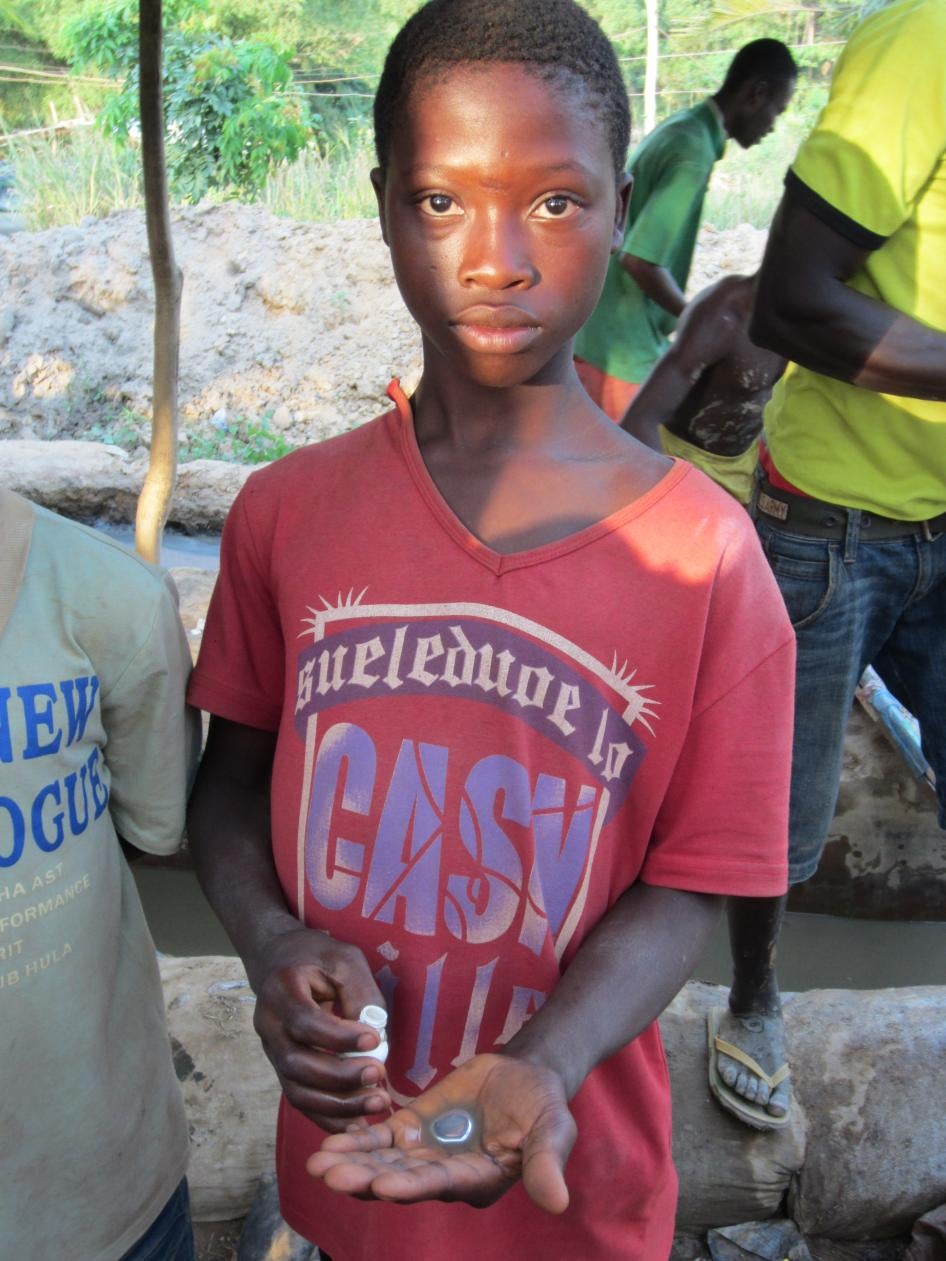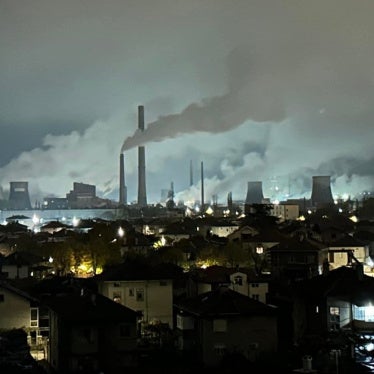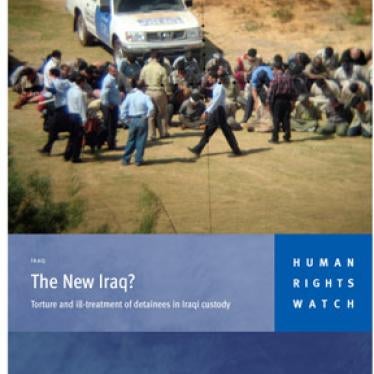Human Rights Watch welcomes the opportunity to contribute to the forthcoming report of the UN special rapporteur on human rights and hazardous substances and wastes, which will focus on children’s rights and hazardous substances.
Human Rights Watch findings on children’s rights and exposure to hazardous substances
Yet, child rights are consistently violated in the context of environmental pollution. According to the World Health Organization, 1.7 million children under the age of five died in 2012 because they lived in an unhealthy environment.[1] Toxic chemicals and substances have particularly harmful consequences for children, whose developing bodies are often more severely affected by toxic exposures than those of adults, leading in some cases to irreversible long-term damage, disability, or even death. Children from poor, disadvantaged, or marginalized backgrounds can be particularly at risk as their communities have limited opportunity to meaningfully participate in decision-making and public debate on environmental issues, and have little access to independent courts to achieve accountability and redress.
Human Rights Watch has conducted research on children’s rights and environmental health for over a decade. We have conducted research in various regions and documented how children are affected by environmental pollution in their daily lives, such as contamination of key resources by toxic substances. We have documented how children work with hazardous substances in a variety of economic sectors.
Children affected by hazardous substances in their daily lives
Human Rights Watch has documented hundreds of cases of government failure to protect children from exposure to hazardous substances. Children have been exposed to hazardous substances while playing on the ground, bathing in rivers, eating or drinking, or simply breathing in toxic gases or dust.
Frequently, the source of the hazardous substances is economic activity, such as manufacturing, mining, or other businesses. For example, in Bangladesh, children have been exposed to chemicals used in tanneries when they bathe in ponds of water contaminated by untreated tannery effluent. Tannery pollution in Bangladesh affects surrounding communities through pollution of water, soil, and air.[2] In China, children have suffered from lead poisoning stemming from nearby smelters and battery factories. The government has intimidated, harassed, and detained parents who sought medical treatment for their children.[3] Similarly, children have been affected by lead exposure from a smelter in Kenya, and protests by local residents and workers have been met with repression.[4]
Pollution from mining—both large-scale and small-scale—has also contributed to children’s exposure to mercury, cyanide, lead, and other toxins.[5] For example, in Kosovo, following the 1999 war, children from the Roma, Ashkali, and Balkan Egyptian communities living in camps for the internally displaced suffered lead poisoning due to contamination from an industrial mine adjacent to the camps. The mine was closed in 2000, but children continued to be exposed to lead and suffer health effects until the closure of the camps in 2013, with insufficient action by the UN Interim Administration in Kosovo (UNMIK), whom the Human Rights Advisory Panel (a body established to adjudicate on certain human rights violations in Kosovo) held responsible for violations inter alia of the Convention on the Rights of the Child (see below).[6] Children living near artisanal and small-scale gold mining sites in Africa or Asia are frequently exposed to toxic mercury, which is used to process gold and frequently emitted into the air, water, or soil.[7] In one of the worst environmental health disasters in recent years, over 400 children died from exposure to lead-contaminated dust produced during artisanal and small-scale gold mining in northern Nigeria.[8]
In addition, children have been exposed to hazardous chemicals when governments have not taken the steps necessary to protect them from naturally-occurring toxins in the ground or groundwater. In Bangladesh, an estimated 20 million children and adults—mostly rural poor—drink water contaminated with arsenic above the national standard. Exposure during pregnancy and childhood is associated with an increased occurrence and/or severity of lung disease, cardiovascular disease, and cancer in childhood and later in life. Exposure to arsenic can also impair cognitive development in children. The government response to arsenic exposure is failing, even though the extent of exposure to arsenic in drinking water has been known for over two decades.[9]
Child laborers affected by hazardous substances in the workplace
Thousands of children work with hazardous substances across different sectors, including mining, leather tanning, and agriculture. According to the International Labour Organization, an estimated 85 million children are engaged in hazardous child labor that puts their health or safety directly at risk, for example through “exposure to hazardous substances, agents and processes.”[10]
Children work with mercury in artisanal and small-scale gold mines in up to 70 countries globally. Human Rights Watch has documented child labor with mercury in Ghana, Mali, the Philippines, and Tanzania. Some children working with mercury were only eight years old. Children usually had little or no information about the risks connected to mercury use. Some child laborers reported to Human Rights Watch that they had developed tremors or other symptoms that are consistent with mercury poisoning.[11]
Human Rights Watch has also documented the use of toxic fertilizers and pesticides by child laborers working with different agricultural crops in the United States, Israel/Palestine, and Indonesia. Several children reported immediate sickness after handling or working in close proximity to pesticides, fertilizers, or other chemical agents. Exposure to pesticides can lead to long-term and chronic health effects, particularly for children whose bodies and brains are still developing.[12]
Children working in tobacco farming are also exposed to nicotine from handling tobacco plants and leaves. Nicotine can be absorbed through the skin and cause acute nicotine poisoning, or Green Tobacco Sickness, an occupational illness specific to tobacco farming. For example, Human Rights Watch found many child tobacco workers in the United States and Indonesia suffer symptoms consistent with acute nicotine poisoning—nausea, vomiting, headaches, and dizziness—while working in tobacco farming.[13]
Child laborers as young as eight have also worked directly with chemicals in tanneries in Bangladesh. Some children work in direct contact with chemicals, handling hides in pits full of chemicals and water. Human Rights Watch found a range of health problems, including skin diseases and respiratory illnesses. Some of these chemicals are known to be confirmed or potential human carcinogens. [14]
National and global measures to address child rights and hazardous substances
This section seeks to respond to the questions posed in the questionnaire distributed to non-governmental organizations by the UN special rapporteur on human rights and hazardous substances and wastes. Human Rights Watch has documented, to a limited extent, encouraging steps by governments at the national or global level designed to protect the child’s right to environmental health, and specifically prevent childhood exposure to hazardous substances. Below are a few examples.
Measures to prevent childhood exposure to hazardous substances
- The 2013 Minamata Convention on Mercury requires treaty parties with artisanal and small-scale gold mining to draw up national action plans that include strategies to prevent mercury exposure of children and women of child-bearing age, especially pregnant women. National action plans shall also include actions to eliminate burning of gold-mercury amalgam in residential areas, where exposure of children is a significant risk.[15] In its guidance on national action plans, the United Nations Environment Program has recommended specific steps to reduce children’s exposure to mercury in the environment, and child labor with mercury.[16] These are unusual steps as most environmental conventions do not explicitly focus on child rights.
- The Philippines government, in conjunction with a non-governmental organization (NGO), has conducted training on mercury-related health conditions for health care workers in artisanal mining areas.[17] The inclusion of health workers in prevention measures is of vital importance.
- In 2015, the US adopted new regulations which prohibit children under the age of 18 from handling pesticides or re-entering fields where pesticides were recently sprayed.[18] The regulation was long overdue and followed years of advocacy by NGOs regarding the harmful effect of pesticides on children’s health.
Steps towards accountability
- On January 10, 2013, Thailand’s supreme administrative court handed down a judgment in a case regarding the toxic legacy of a former privately owned lead processing factory that had contaminated Klity Creek, a stream in western Thailand. The court found Thailand’s Pollution Control Department—the government body charged with preventing and resolving pollution problems—negligent for being too slow to clean up. The court ordered the department to pay a total of nearly four million baht (US$125,000) in compensation distributed among the 22 plaintiffs. For the first time in Thailand’s history, a superior court also ordered the government to clean up a toxic site. The decision could constitute an important step towards accountability if Thailand’s Pollution Control Department undertakes a thorough clean-up of the site.
- In February 2016, the UN Human Rights Advisory Panel issued an opinion that found that the UN Interim Administration in Kosovo (UNMIK) had failed to protect the rights of Roma, Ashkali, and Egyptian communities from lead exposure, and recommended amongst other measures that UNMIK pay compensation and issue a public apology to victims and their families.[19] The Human Rights Advisory Panel is a body set up to examine complaints of alleged human rights violations committed by or attributable to UNMIK and makes recommendations to the special representative of the secretary-general (SRSG) in Kosovo when appropriate. The Panel’s decision could constitute a first step towards accountability if UNMIK does indeed pay compensation and issue an apology.
Additional issues
We would like to share a few broader lessons that we draw from our work on children’s rights and hazardous substances.
- Health rights: Any measure to protect children from exposure to hazardous substances should include specific measures for the prevention, testing, and treatment of health conditions connected to exposures. The World Health Organization (WHO), national health ministries and health sectors, and health NGOs need to be directly involved in efforts to ensure the fulfillment of the child’s right to protection from exposure to hazardous substances. An example for a step in this direction is the inclusion of health provisions in the Minamata Convention on Mercury and the WHO’s resolution on the Convention, endorsing it and recommending specific action to health ministries.[20]
- Labor rights: Any measure to protect children from exposure to hazardous substances should include specific measures relating to labor rights, in particular occupational health and safety and child labor. Environmental and labor issues are not always integrated sufficiently. The International Labour Organization, national labor ministries, trade unions, and employers need to be directly involved in efforts to ensure the fulfillment of the child’s right to protection from exposure to hazardous substances.
- The role of governments relating to business: In order to uphold their child rights duties, governments need to regulate the business sector both domestically and abroad. While they often regulate company behavior at the domestic level, governments have consistently failed to oversee or regulate the extraterritorial human rights practices of their companies. The UN General Comment on child rights and businesses provides detailed guidance on the responsibility of states, including where due diligence requirements should be made mandatory.[21]
- Business responsibility: Companies have a responsibility to ensure that their actions do not cause, contribute to, or are linked with violations of human rights, including the child’s right to health. Businesses have a responsibility to respect human rights in their own company activities as well as in their business relationships in supply chains. Companies have a responsibility not only when multinational companies have direct ownership over subsidiaries abroad, but also when supply chains involve numerous suppliers or businesses that belong to the informal sector. Any measure to protect children from exposure to hazardous substances should include specific measures relating to businesses.
Human Rights Watch recommends that the UN special rapporteur on human rights and hazardous substances and wastes call upon states to take measures to prevent children’s exposure to hazardous substances, including by:
- Assessing risks relating to children’s exposure to hazardous substances on an ongoing basis and take steps to protect children accordingly.
- Preventing, testing, and treating children’s exposure to hazardous substances. This should include regular of monitoring children’s level of exposure to hazardous substances, health worker training, and other steps to boost health system capacity if necessary.
- Tackling hazardous child labor. This should be done through enforcement of existing and adoption of new laws and regulations designed to protect children from hazardous child labor; regular work place inspections; programs to withdraw children from hazardous child labor; public education and training on the risks to children of work with hazardous substances; efforts to ensure that alternative opportunities for legal youth employment above the legal minimum age are available; measures to make access to education free of charge; and financial support programs, such as social protection schemes, for the poorest families.
- Regulating businesses to ensure they respect the child’s right to environmental health in their own operations as well as in their supply chains. In particular, require companies to conduct thorough supply chain due diligence regarding children’s exposure to hazardous substances.
- Protecting the right to information on environmental health, as guaranteed under international and regional human rights law, as well as freedom of expression and information.
- Investigating and holding to account, including if appropriate and there is sufficient evidence through prosecution, those responsible for violations of the child’s right to environmental health.
- Investigating and holding to account, including if appropriate and there is sufficient evidence through prosecution, those responsible for violations of the right to information, freedom of expression, or freedom assembly relating to child rights and hazardous substances.
[1] World Health Organization, “An estimated 12.6 million deaths each year are attributable to unhealthy environments,” March 15, 2016, http://www.who.int/mediacentre/news/releases/2016/deaths-attributable-to-unhealthy-environments/en/ (accessed April 14, 2016).
[2] Human Rights Watch, Bangladesh—Toxic Tanneries: The Health Repercussions of Bangladesh’s Hazaribagh Leather, October 2013, https://www.hrw.org/report/2012/10/08/toxic-tanneries/health-repercussions-bangladeshs-hazaribagh-leather, pp. 42-45, 61-66.
[3] Human Rights Watch, China—“My Children Have Been Poisoned:” A Public Health Crisis in Four Chinese Provinces, June 2011, https://www.hrw.org/report/2011/06/15/my-children-have-been-poisoned/public-health-crisis-four-chinese-provinces.
[4] Jane Cohen (Human Rights Watch), “Dispatches: Hope for Kenya´s Lead Poisoning Victims”, Human Rights Watch dispatches, August 13, 2014, https://www.hrw.org/news/2014/08/13/dispatches-hope-kenyas-lead-poisoning-victims.
[5] Human Rights Watch, Papua New Guinea—Gold's Costly Dividend: Human Rights Impacts of Papua New Guinea's Porgera Gold Mine, February 2011, https://www.hrw.org/sites/default/files/reports/png0211webwcover.pdf; Human Rights Watch, India—Out of Control: Mining, Regulatory Failure, and Human Rights in India, June 2012, https://www.hrw.org/report/2012/06/14/out-control/mining-regulatory-failure-and-human-rights-india.
[6] Human Rights Watch, Kosovo—Poisoned by Lead: A Health and Human Rights Crisis in Mitrovica’s Roma Camps, June, 2009, https://www.hrw.org/report/2009/06/23/kosovo-poisoned-lead/health-and-human-rights-crisis-mitrovicas-roma-camps.
[7] Human Rights Watch, Philippines—“What … if Something Went Wrong?” Hazardous Child Labor in Small-Scale Gold Mining in the Philippines, September 2015, https://www.hrw.org/report/2015/09/29/what-if-something-went-wrong/hazardous-child-labor-small-scale-gold-mining; Human Rights Watch, Tanzania—Toxic Toil: Child Labor and Mercury Exposure in Tanzania’s Small-Scale Gold Mines, August 2013, https://www.hrw.org/report/2013/08/28/toxic-toil/child-labor-and-mercury-exposure-tanzanias-small-scale-gold-mines.
[8] Human Rights Watch, “Nigeria: Child Lead Poisoning Crisis -Treat Thousands of Affected Children; Clean Villages; Improve Gold Mining Practices,” Human Rights Watch news release, February 7, 2012, https://www.hrw.org/news/2012/02/07/nigeria-child-lead-poisoning-crisis.
[9] “Bangladesh: 20 Million Drink Arsenic-Laced Water,” Human Rights Watch news release, April 6, 2016, https://www.hrw.org/news/2016/04/06/bangladesh-20-million-drink-arsenic-laced-water.
[10] Such exposure is part of the definition of hazardous child labor, prohibited for anyone under the age of 18. International Labour Organization, Recommendation 190, Recommendation concerning the prohibition and immediate action for the elimination of the worst forms of child labor (Eighty-seventh session, 1999), 17 June 1999, http://www.ilo.org/public/english/standards/relm/ilc/ilc87/com-chir.htm (accessed April 15, 2016).
[11] Human Rights Watch, Ghana—Precious Metal, Cheap Labor: Child Labor and Corporate Responsibility in Ghana’s Artisanal Gold Mines, June 2015, https://www.hrw.org/report/2015/06/10/precious-metal-cheap-labor/child-labor-and-corporate-responsibility-ghanas, Human Rights Watch, Mali—A Poisonous Mix: Child Labor, Mercury, and Artisanal Gold Mining in Mali, December 2011, https://www.hrw.org/report/2011/12/06/poisonous-mix/child-labor-mercury-and-artisanal-gold-mining-mali.
[12] Human Rights Watch, United States—Fields of Peril: Child Labor in US Agriculture, May 2010, https://www.hrw.org/report/2010/05/05/fields-peril/child-labor-us-agriculture; Human Rights Watch, United States—Tobacco’s Hidden Children: Hazardous Child Labor in United States Tobacco Farming, May 2014, https://www.hrw.org/report/2014/05/13/tobaccos-hidden-children/hazardous-child-labor-united-states-tobacco-farming; Human Rights Watch, Israel/Palestine—Ripe for Abuse: Palestinian Child Labor in Israeli Agricultural Settlements in the West Bank, April 2015, https://www.hrw.org/report/2015/04/13/ripe-abuse/palestinian-child-labor-israeli-agricultural-settlements-west-bank.
[13] Human Rights Watch, United States-Tobacco’s Hidden Children.
[14] Human Rights Watch, Bangladesh—Toxic Tanneries: The Health Repercussions of Bangladesh’s Hazaribagh Leather, October 2013, https://www.hrw.org/report/2012/10/08/toxic-tanneries/health-repercussions-bangladeshs-hazaribagh-leather, pp. 42-45, 61-66.
[15] United Nations Environment Programme (UNEP), “Minamata Convention on Mercury,” October 2013, http://www.mercuryconvention.org/Portals/11/documents/Booklets/Minamata%20Convention%20on%20Mercury_booklet_English.pdf, Article 7, Annex C (accessed April 15, 2016).
The treaty has been ratified by 25 countries and will enter into force when it has been ratified by 50 countries.
[16] UNEP, “Guidance Document: Developing a National Action Plan to Reduce, and Where Feasible, Eliminate Mercury Use in Artisanal and Small Scale Gold Mining,” August 17, 2015, http://www.unep.org/chemicalsandwaste/Portals/9/Mercury/Documents/ASGM/National%20Action%20Plan_draft%20guidance%20v12.pdf (accessed April 15, 2016), p.64-66.
[17] Human Rights Watch, Philippines— “What … if Something Went Wrong?”
[18] Revisions to the Worker Protection Standard,” United States Environmental Protection Agency (EPA) press release, https://www.epa.gov/pesticide-worker-safety/revisions-worker-protection-standard (accessed April 15, 2016); Margaret Wurth (Human Rights Watch), “Finally – US to Protect Child Farmworkers from Pesticides,” Human Rights Watch dispatches, September 29, 2015, https://www.hrw.org/news/2015/09/29/dispatches-finally-us-protect-child-farmworkers-pesticides.
[19] The Human Rights Advisory Panel, N.M. and Others v. UNMIK (Case No. 26/08), opinion of February 26, 2016, http://www.unmikonline.org/hrap/Eng/Cases%20Eng/26-08%20NM%20etal%20Opinion%20FINAL%2026feb16.pdf (accessed April 25, 2016). The panel noted that “the heavy exposure to contamination, coupled with poor living conditions in the camps, a situation which lasted for more than 10 years was such as to pose a real and immediate threat to the complainants’ life and physical integrity. The Panel also considers established the bad health conditions incurred by the complainants, and especially by children and pregnant women, as a result of their prolonged exposure to lead.” See also Katharina Rall (Human Rights Watch), “A glimmer of hope for Kosovo´s lead poisoning victims,” Human Rights Watch dispatches, April 13, 2016, https://www.hrw.org/news/2016/04/13/dispatches-glimmer-hope-kosovos-lead-poisoning-victims.
[20] Juliane Kippenberg, (Human Rights Watch), “Heavy Metal Victory,” Human Rights Watch dispatches, January 23, 2014, https://www.hrw.org/news/2014/01/23/dispatches-heavy-metal-victory.
[21] UN Committee on the rights of the Child, General Comment No. 16 on State obligations regarding the impact of the business sector on children’s rights, UN Doc CRC/C/GC/ (2013).







